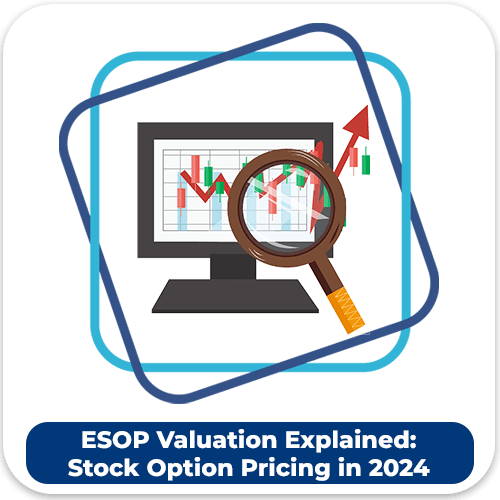Valuation of ESOP: Understanding the Key Elements
Employee Stock Options Plans (ESOPs) have become a popular compensation tool, particularly in the startup world, to incentivize and reward key employees. ESOPs give employees the opportunity to own shares of the company at a predetermined price, benefiting from the company’s growth over time.
But how do we determine the value of these options? This article explores the intricate process of ESOP valuation and the key variables influencing it. We will break down the components, discuss commonly used valuation models, and explain why these factors matter to companies and employees alike.

What is an ESOP?
An Employee Stock Options Plan (ESOP) grants employees the right to buy a specific number of company shares at a fixed price, known as the “exercise price” or “strike price,” at a future date. The value of the ESOP depends largely on the market value of the company’s shares at the time of exercise compared to the strike price.
Why Are ESOPs Important?
ESOPs serve as a retention and motivation tool. Employees are motivated to help the company succeed because their potential financial gain is tied to the company’s performance. If the company does well, the share price increases, and employees can buy shares at a lower price, reaping significant rewards.
Key Variables Impacting ESOP Valuation
Valuing an option is not as straightforward as simply considering the current stock price. Various factors influence the value of an ESOP, including:
1. Current Value of the Underlying Asset
The underlying asset is the company’s stock, and its current value plays a central role in determining the option’s worth. As the stock price rises, the value of the ESOP increases, providing more potential profit for the employee.
2. Variance in Value (Volatility)
The more volatile a company’s stock, the more the potential value of the ESOP fluctuates. High volatility can increase the option’s value because it means there’s a greater chance that the stock price could rise significantly above the strike price before the option expires.
3. Dividends
Dividends can affect ESOP valuation, especially in cases where the company pays out dividends during the option’s life. When a company pays dividends, the stock price typically decreases, which could reduce the option’s value.
4. Strike Price
The strike price is the price at which the employee can buy shares once the option is exercised. If the strike price is low compared to the current market value, the option has more intrinsic value. Conversely, a high strike price reduces the attractiveness of the option.
5. Time to Expiration
ESOPs with a longer time to expiration have more value because they give the employee more time to benefit from potential stock price increases. The longer the time frame, the higher the likelihood that the stock price will move favorably.
6. Risk-Free Interest Rate
The risk-free interest rate, typically represented by government bonds, can also impact the valuation of ESOPs. Higher interest rates can decrease the present value of future cash flows from options.
Commonly Used ESOP Valuation Models
Several models are used to value stock options, each with its own advantages and limitations. These models consider the above factors to estimate the fair market value of the option.
1. Black-Scholes Model
The Black-Scholes Model is the most widely used option pricing model. It calculates the price of an option based on factors like stock price, strike price, time to expiration, volatility, and risk-free interest rate. While highly popular, it is best suited for European options, which can only be exercised at expiration, not before.
2. Binomial Model
The Binomial Model breaks down the option’s life into multiple time intervals, calculating potential future stock prices at each step. It is more flexible than the Black-Scholes Model because it allows for American-style options, which can be exercised at any time before expiration.
3. Monte Carlo Simulation Model
The Monte Carlo Simulation Model is used for more complex options, such as those with path-dependent features (e.g., ESOPs with vesting schedules). It simulates various potential stock price paths over time to determine the option’s value. This model is highly adaptable but computationally intensive.
Why is ESOP Valuation Important for Employees and Companies?
1. For Employees
Employees need to understand the value of their stock options to make informed decisions about when to exercise them. By valuing their ESOPs accurately, employees can maximize the benefits of owning company shares and plan for their financial future.
2. For Companies
Accurate ESOP valuation is essential for financial reporting and compliance. Companies must account for the cost of granting stock options, which can have significant tax implications and affect the company’s financial statements.
3. Taxation of ESOPs
Employees should also be aware of the tax implications of exercising ESOPs. The difference between the market value of the stock at the time of exercise and the strike price is taxed as income, while any gain after that is taxed as capital gains.
Challenges in ESOP Valuation
Valuing ESOPs can be complex, particularly in private companies where there’s no readily available market price for the stock. Companies must rely on independent valuations, which can be costly and time-consuming. Additionally, the lack of liquidity in private company shares adds another layer of complexity.
Key Considerations in Private Companies
In the case of private companies, it’s essential to conduct an independent fair market valuation. This ensures compliance with regulatory standards like Section 409A of the Internal Revenue Code in the U.S., which governs the taxation of deferred compensation.
Best Practices for ESOP Valuation
1. Regular Valuation Updates
Companies should regularly update their ESOP valuations, especially in periods of rapid growth or change. This helps ensure that employees are provided with accurate information regarding the value of their options.
2. Independent Appraisals
It’s advisable to use independent valuation experts to maintain fairness and accuracy, particularly for private companies.
3. Transparency with Employees
Clear communication with employees about the valuation process and the factors affecting their options’ value is key to fostering trust and loyalty.
Conclusion
Valuing ESOPs is a nuanced process that requires consideration of various factors, including the current stock price, volatility, time to expiration, and more. By understanding these variables and the models used to estimate value, employees and companies can maximize the benefits of stock options. Proper valuation ensures that both parties are informed and can make the best decisions when it comes to ESOPs.
FAQs
- What is the best model to value ESOPs?
The Black-Scholes model is most commonly used but can be less effective for complex options like those with vesting schedules, where the Monte Carlo simulation may be better. - Are ESOPs taxable when exercised?
Yes, the difference between the market value of the stock at exercise and the strike price is taxed as income. - Can ESOPs lose value?
Yes, if the stock price falls below the strike price, the ESOP can become worthless. - What happens if I leave the company before my ESOPs vest?
Unvested options typically expire, meaning you cannot exercise them. - How does volatility affect ESOP value?
Higher volatility increases the potential value of an ESOP because it increases the likelihood that the stock price will rise significantly.

